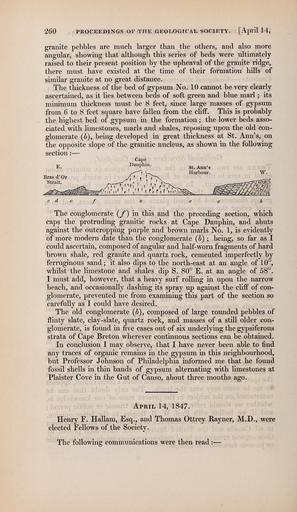MAKE A MEME
View Large Image

| View Original: | The_Quarterly_journal_of_the_Geological_Society_of_London_(13206154384).jpg (1199x2069) | |||
| Download: | Original | Medium | Small | Thumb |
| Courtesy of: | commons.wikimedia.org | More Like This | ||
| Keywords: The Quarterly journal of the Geological Society of London (13206154384).jpg 260 PROCEEDINGS OF THE GEOLOGICAL SOCIETY April 14 <br> granite pebbles are much larger than the others and also more <br> angular showing that although this series of beds were ultimately <br> raised to their present position by the upheaval of the granite ridge <br> there must have existed at the time of their formation hills of <br> similar granite at no great distance <br> The thickness of the bed of gypsum No 10 cannot be very clearly <br> ascertained as it lies between beds of soft green and blue marl ; its <br> minimum thickness must be 8 feet since large masses of gypsum <br> from 6 to 8 feet square have fallen from the cliff This is probably <br> the highest bed of gypsum in the formation ; the lower beds asso- <br> ciated with limestones marls and shales reposing upon the old con- <br> glomerate 6 being developed in great thickness at St Ann's on <br> the opposite slope of the granitic nucleus as shown in the following <br> section ” <br> Cape <br> p Dauphin <br> The conglomerate / in this and the preceding section which <br> caps the protruding granitic rocks at Cape Dauphin and abuts <br> against the outcropping purple and brown marls No 1 is evidently <br> of more modern date than the conglomerate 6 ; being so far as I <br> could ascertain composed of angular and half-worn fragments of hard <br> brown shale red granite and quartz rock cemented imperfectly by <br> ferruginous sand ; it also dips to the north-east at an angle of 1 0° <br> whilst the limestone and shales dip S 80° E at an angle of 58° <br> I must add however that a heavy surf rolHng in upon the narrow <br> beach and occasionally dashing its spray up against the chff of con- <br> glomerate prevented me from examining this part of the section so <br> carefully as I could have desired <br> The old conglomerate 5 composed of large rounded pebbles of <br> flinty slate clay-slate quartz rock and masses of a still older con- <br> glomerate is found in five cases out of six underlying the gypsiferous <br> strata of Cape Breton wherever continuous sections can be obtained <br> In conclusion I may observe that I have never been able to find <br> any traces of organic remains in the gypsum in this neighbourhood <br> but Professor Johnson of Philadelphia informed me that he found <br> fossil shells in thin bands of gypsum alternating with limestones at <br> Plaister Cove in the Gut of Canso about three months ago <br> April 14 1847 <br> Henry F Hallam Esq and Thomas Ottrey Rayner M D were <br> elected Fellows of the Society <br> The following communications were then read ” 36932999 113687 51125 Page 260 Text v 3 http //www biodiversitylibrary org/page/36932999 1847 Geological Society of London Biodiversity Heritage Library The Quarterly journal of the Geological Society of London v 3 1847 Geology Periodicals Smithsonian Libraries bhl page 36932999 dc identifier http //biodiversitylibrary org/page/36932999 smithsonian libraries Information field Flickr posted date ISOdate 2014-03-17 Check categories 2015 August 26 CC-BY-2 0 BioDivLibrary https //flickr com/photos/61021753 N02/13206154384 2015-08-26 12 55 19 cc-by-2 0 PD-old-70-1923 The Quarterly journal of the Geological Society of London 1847 Photos uploaded from Flickr by Fæ using a script | ||||